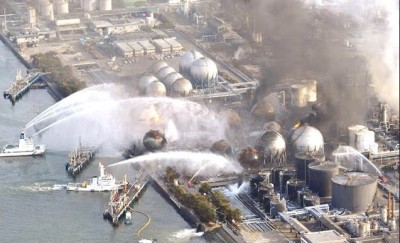Fukushima: “Worst Industrial Cataclysm in World History”, Nuclear Engineer Arnie Gundersen
"As Close to Hell as I can Imagine”

Arnie Gundersen, former nuclear engineer, Mar 11, 2017: “The scientific impact of the triple meltdown at Fukushima Daiichi is an ongoing disaster that was never envisioned by the engineers who created and designed these atomic reactors and countries who built them… no country in the world with nuclear power reactors was prepared for the explosive radioactive contamination of Fukushima Daiichi.”
Over and over, people ask me about what happened inside the plants and what is still happening inside with robots fried by radiation, corium that can’t be found, and massive amounts of radioactivity migrating to sensitive estuaries, aquifers, contaminating all the ground water, and polluting the Pacific Ocean…
No one has discovered where the nuclear cores have disappeared to. The $400,000,000 “ice wall” continues to leak…
Moreover, the cover-up continues, with the health effects from radiation being camouflaged as stress related illnesses…
I decided to share the photographs I took last year in Japan… these photos cannot adequately convey the scientific and human impact of the worst industrial cataclysm in the history of the world… [R]adioactive isotopes will be extreme hazards for 250,000 years, of course no one knows when it will end.
BBC Newsday interview with nuclear engineer Arnie Gundersen, Feb 28, 2017:
“As they get in [the containment vessel at Fukushima Daiichi Unit 2], they’re finding that combination of hot steam — these are not just radioactive chemicals, but it’s a toxic mix of chemicals that are going to react with the steel. So there’s rust and hunks of nuclear fuel lying around, and steam, and it’s raining all the time because of the condensation. I think it’s about as close to hell as I could imagine.”
Arjun Makhijani, nuclear engineer, Feb 17, 2017:
Yes, so the bottom of the reactor under the reactor there is a grating and then under the grating there’s the concrete floor, and what this robot discovered… the grating was deformed and broken. So, now it appears that some of the molten fuel may have gone through the grating… [H]igh radiation turns into heat, so the whole environment around the molten fuel is thermally very hot, and so whether it is going through the concrete, whether it is under the concrete, I don’t know that we have a good grip on that issue… Fukushima is possibly the longest running, continuous industrial disaster in history. It has not stopped because the risks are still there.
Interview with Gundersen here | Interview with Makhijani here

